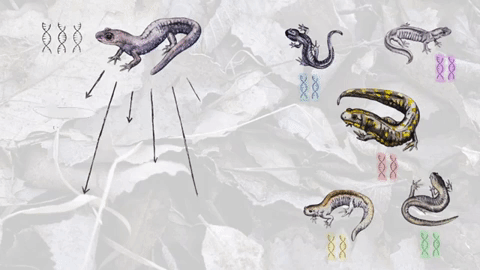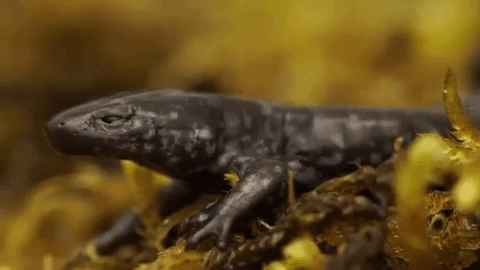Meet the mole salamander. This species seems like many of the salamanders you may find in ponds in the Midwest, with one major difference: some populations of them are unisexual, or are females that can reproduce without males. And in that way, they have a leg up on other animals.
“If you think about it, a lineage that’s all made up of females can actually grow twice as fast as a lineage that has both males and females,” says Katy Greenwald, an associate professor at Eastern Michigan University. “We sometimes call this ‘the twofold cost of males,’” adds Rob Denton, an assistant professor at the University of Minnesota Morris. “It costs to make males. And males take away resources that could be used for females.”
While these salamanders don’t need male mates, they do need their sperm. So they steal it by picking up sperm packets that the males leave lying around in an act known as kleptogenesis. “[They] require that sperm just to even have eggs, to produce eggs and lay them. Most of [their] offspring are clones of mom,” says Denton. “They have all the same chromosomes, all the same genetic material.” But the few offspring that aren’t clones have a genetic twist.
All offspring of sexually reproducing organisms have two sets of chromosomes: one from mom and one from dad. That may not be necessarily true for the non-clone mole salamander offspring. “[We] sometimes get [unisexual salamanders] with two sets. But it’s much more common for them to have three or four sets. And we sometimes even find them with five. Five tends to be about where they max out,” says Greenwald.

Things get stranger from there. Because these salamanders are only female, the sperm packets that they steal have to come from different species. The particular population of salamanders the researchers are studying is able to reproduce from five different salamander species that it lives next to. “Even within a single clutch of eggs where those are all siblings, all sisters, you may have actually different types of salamanders being produced,” says Greenwald.
“But I think what puts it into perspective,” says Denton, “is how distantly related these species are that are sharing this genetic information. If we were to take a sample of my blood and I had a set of chromosomes from my mother, from my father, but in addition, a whole set from a gorilla, from an orangutan, from a chimpanzee, that’s the type of evolutionary divergence between these salamanders. But I would be a fully functioning normal human being.”
Scientists don’t know why these salamanders evolved in this way and they’re trying to find out how the mom chooses what genetic material to pass on to its offspring—if she even chooses at all. But this process, though complex, does provide an evolutionary advantage. If all the salamanders were clones and shared the same genetic material, the species would be at risk of extinction if a deadly disease spread through the population. But since there’s even a small amount of genetic variation, they’ve been able to survive.

“These salamanders really are taking advantage of the system,” says Greenwald. “They’re all-female, so they don’t bear that cost of producing males. But they’re occasionally incorporating DNA from other species. In some ways, it seems like this potentially totally unique evolutionary win-win, which might ultimately let us learn a little bit more about the evolution and maintenance of sexual reproduction.”
Correction (5/22/19): The sperm packets that the females pick up are not from other populations, but other species.
Credits
Produced by Katie Garrett
Article by Daniel Peterschmidt
Music by Audio Network
Special Thanks to Kelsie Mitchel, Katherine Novak, Gregory Schneider
Meet the Producers and Host
About Katie Garrett
@katieggarrettKatie Garrett is a filmmaker, biologist, photographer, and artist. She has produced film pieces for National Geographic, Geographical Magazine (Royal Geographical Society), bioGraphic (California Academy of Sciences), Ensia, and Operation Wallacea.
About Dee Peterschmidt
Dee Peterschmidt is a producer, host of the podcast Universe of Art, and composes music for Science Friday’s podcasts. Their D&D character is a clumsy bard named Chip Chap Chopman.